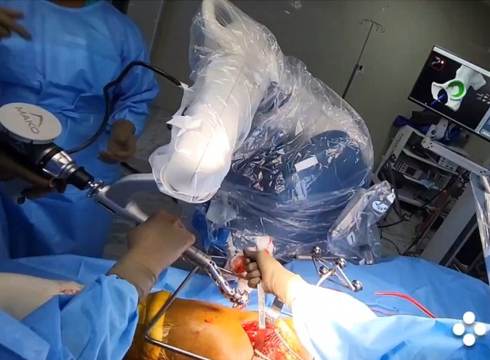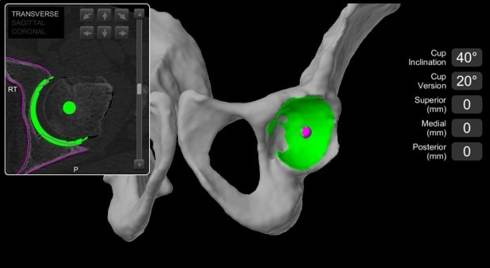Robotic Hip Replacement Surgery
What Is Robotic Hip Replacement Surgery?
In robotic hip replacement surgery, our Orthopaedic Surgeons use highly advanced, surgeon-controlled robotic-arm assisted technology to restore the functioning and integrity of the hip joint by removing the damaged hip joint and replacing it with a prosthesis (implant). Robotic hip replacement surgery is similar to conventional hip replacement surgery, except that it uses the Mako Robotic-Arm Assisted technology which creates a personalized pre-operative plan that enables our Orthopaedic surgeons to achieve accurate alignment of the implant in the hip joint. Thus, robotic hip replacement surgery enhances greater precision and accuracy, which is important for better outcomes for patients.
Why Is It Done?
If you have severe hip joint inflammation, discomfort, and damage due to osteoarthritis, rheumatoid arthritis, osteonecrosis, an injury such a hip fracture, or a tumor in the hip joint, your orthopaedic surgeon may suggest hip replacement surgery. In such cases, the hip joint is worn or damaged, which can make it difficult to walk or get in and out of a chair and in some cases the pain can prevent you from sleeping.
What Happens during the Procedure?
A 3D virtual model of your joint is created using the CT scan images obtained prior to surgery. Your doctor will use the 3D CT-based model for patient-specific surgical planning, assessing your bone structure, the severity of your condition, the alignment of your joints, and the surrounding bone and tissue. This will help to determine the ideal implant size, location, and alignment.
During surgery, your surgeon locates tracking points in the hip in order to register your anatomy in the Mako system. The surgeon guides the Mako robotic arm to remove arthritic bone and cartilage from the hip. Mako’s Accustop™ technology creates a virtual boundary that provides a tactile resistance to help the surgeon stay within the boundaries defined in the pre-operative plan. The Mako provides real time data to your surgeon, allowing the surgeon to assess the movement and tension of your joint and adjust the surgical plan, if required. The robotic arm guides the surgeon for placement of the implant. The robot is moved away and the incision site is closed.
How Long Will It Take?
Robotic hip replacement surgery takes one to two hours approximately depending on your condition. The surgeon will explain to you in detail about the procedure.
What Happens After The Procedure?
Post-surgery, your surgeon will monitor your condition and progress. Patients undergoing robotic hip replacement surgery generally recover faster than conventional hip replacement surgery. Depending on your condition and co-morbidities, a follow-up appointment will be scheduled and your discharge will be planned accordingly.
Every patient recovers at a different pace. Your surgeon will advise you when and what activities you can perform, and what activities are to be avoided. After 5 to 12 weeks of physical therapy, most of patients are able to resume their regular activities. Though it varies from patient to patient, the average recovery period is 3 to 6 months.
Apollo Expertise in the Procedure
The Apollo Institute of Orthopedics offers cutting-edge minimally invasive robotic surgical techniques and technology. At Apollo Hospitals, Chennai, we offer a revolutionary solution for patients struggling with chronic hip pain and considering hip replacement surgery: Robotic hip replacement with the Mako System. This innovative technology delivers unparalleled accuracy and potential benefits for a faster and smoother recovery. Robotic hip replacement surgery has revolutionized the hip replacement concept.
Apollo Hospitals, Chennai, takes pride in being the first and only healthcare facility in Tamil Nadu to offer robotic hip replacement using the Mako System. Since August 2022, our expert Orthopaedic Surgeons have successfully performed numerous robotic hip replacements thus helping patients regain their mobility and quality of life.
FAQs
How will life be after Robotic Hip Replacement Surgery?
Robotic hip replacement surgery can enhance the life and natural feel of the joint implant.
After surgery, for a few weeks, you will have limited activity to allow your joint to heal and recover. You will need to use crutches to provide support to your hip for a couple of weeks. In order to promote healing and in order to avoid joint stiffness and circulation problems, walking is usually advised.
Physical therapy plays a vital role in your recovery. Regular therapy sessions will speed up the healing process, strengthen the surrounding muscles of the joint, and restore joint movement and functioning. After therapy, most patients resume their normal activities, depending on what caused the hip problem.
What Is The Advantage Of Robotic Hip Replacement Surgery?
- Unparalleled Accuracy in Cup Position: The Mako System utilizes 3D CT scans to create a personalized virtual model of your hip. This allows our experienced surgeons to plan and place the implant with unmatched precision, minimizing the risk of complications and ensuring optimal long-term function.
- Fine Adjustment of Leg Length: Unlike traditional surgery, the Mako System helps preserve your natural bone and soft tissue, enabling our surgeons to fine-tune your leg length and restore a natural gait, improving balance and stability.
- Reduced Risk of Dislocation: Utilizing a virtual range of movement simulation, the Mako System helps optimize implant placement to avoid impingement and potential dislocation, a major concern with traditional hip replacement.
- Minimally Invasive Approach: Robotic assistance allows for smaller incisions, leading to less tissue damage, potentially shorter hospital stays, and faster recovery times.
Am I a suitable candidate For Robotic Hip Replacement Surgery?
Although there are many advantages of robotic hip replacement surgery, not everyone is a good candidate. Our doctor will perform a detailed evaluation to determine if robotic hip replacement surgery is right for you. These assessments include digital imaging of your hip joint to evaluate the extent of your cartilage, joint, or bone damage.
If you are healthy and have not improved with conservative treatment, robotic assisted hip replacement can be a good option for you. Factors that may prevent you from undergoing this procedure include a higher risk of infection, significant thinning of your bones, obesity etc. We suggest you schedule a consultation with our expert orthopaedic surgeon to discuss if robotic hip replacement with the Mako System is right for you.


UPDATED ON 03/09/2024
Apollo Highlights & Updates
 Apollo Hospitals takes up a 4.5-Hour Stroke Treatment Promise with Advanced Stroke Care Network with Extended 24-Hour Tr...
Apollo Hospitals takes up a 4.5-Hour Stroke Treatment Promise with Advanced Stroke Care Network with Extended 24-Hour Tr...© Copyright 2024. Apollo Hospitals Group. All Rights Reserved.
 +91 8069991061
Book Health Check-up
+91 8069991061
Book Health Check-up








